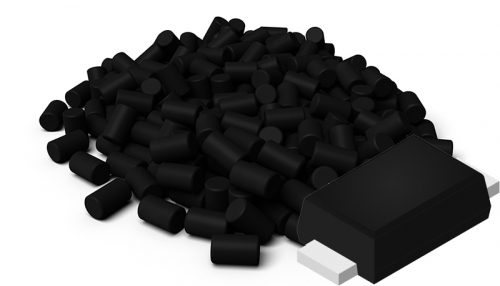Hysol GR640HV | Black Epoxy Mold Compound
- EMC for small outline packages including SOD, SOT and SMX
- JEDEC 1 260°C capable product
- Excellent electrical performance
Product Description
Hysol GR640HV is a black, transfer molded semiconductor epoxy molding compound. Once transfer molded and post-mold cured, it has excellent mechanical and electrical properties. It offers an excellent balance between outstanding performance, low stressm ease of use (which allows multiple shots between cleaning) and low cost of ownership.
Hysol GR640HV is an environmentally "green" product, meaning that it doesn't contain any bromine, antimony or phosphorus flame retardants. This material is designed to achieve JEDEC Level 1 requirements at 260°C reflow temperature on small outline packages including SOT, SOD and SMX package types. Hysol GR640HV meets UL 94 V-0 Flammability at 1/8 inch (3.175mm) thickness.
Hysol GR640HV is designed for the following semiconductor discrete packages:
- Small outline transistor (SOT) packages
- Small outline device (SOD) packages
- SMA, SMB and other SMX packages
Technical Specifications
| General Properties | |
| Color Color The color | Black |
| Filler Content | 74 % |
| Specific Gravity Specific Gravity Specific gravity (SG) is the ratio of the density of a substance to the density of a reference substance; equivalently, it is the ratio of the mass of a substance to the mass of a reference substance for the same given volume. For liquids, the reference substance is almost always water (1), while for gases, it is air (1.18) at room temperature. Specific gravity is unitless. | 1.83 |
| Thermal Properties | |
| Glass Transition Temperature (Tg) Glass Transition Temperature (Tg) The glass transition temperature for organic adhesives is a temperature region where the polymers change from glassy and brittle to soft and rubbery. Increasing the temperature further continues the softening process as the viscosity drops too. Temperatures between the glass transition temperature and below the decomposition point of the adhesive are the best region for bonding. The glass-transition temperature Tg of a material characterizes the range of temperatures over which this glass transition occurs. | 160 °C |
| Thermal Conductivity Thermal Conductivity Thermal conductivity describes the ability of a material to conduct heat. It is required by power packages in order to dissipate heat and maintain stable electrical performance. Thermal conductivity units are [W/(m K)] in the SI system and [Btu/(hr ft °F)] in the Imperial system. | 0.85 W/m.K |
| UL 94 Rating UL 94 Rating Flammability rating classification. It determines how fast a material burns or extinguishes once it is ignited. HB: slow burning on a horizontal specimen; burning rate less than 76 mm/min for thickness less than 3 mm or burning stops before 100 mm V-2: burning stops within 30 seconds on a vertical specimen; drips of flaming particles are allowed. V-1: burning stops within 30 seconds on a vertical specimen; drips of particles allowed as long as they are not inflamed. V-0: burning stops within 10 seconds on a vertical specimen; drips of particles allowed as long as they are not inflamed. 5VB: burning stops within 60 seconds on a vertical specimen; no drips allowed; plaque specimens may develop a hole. 5VA: burning stops within 60 seconds on a vertical specimen; no drips allowed; plaque specimens may not develop a hole | V0 |
| Electrical Properties | |
| Volume Resistivity Volume Resistivity Volume resistivity, also called volume resistance, bulk resistance or bulk resistivity is a thickness dependent measurement of the resistivity of a material perpendicular to the plane of the surface. | 6.0x1015 Ohms⋅cm |
| Mechanical Properties | |
| Molded Shrinkage | 0.25 % |
| Chemical Properties | |
| Moisture absorption | 0.52 % |
| Physical Properties | |
| Spiral Flow @ 175°C | 75 cm |
| Curing Conditions | |
| Transfer Pressure | 40 - 100 kg/cm2 |
| Transfer Time | 10 - 15 s |






